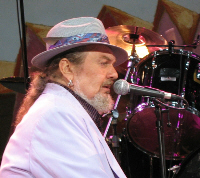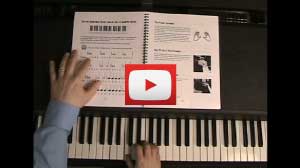New Orleans Blues Pianists
Professor Longhair, Dr.John, James Booker, Marcia Ball, Tuts Washington
New Orleans blues pianists mixed the sounds of boogie woogie, swing, Latin rhumba, and the beat of the second line to create a piano sound that is unique. New Orleans played a huge role in the development of jazz and blues, and the piano played a bigger part of that role in the Crescent city more than in any other locale.
As far back as the first decade of the 20th century, New Orleans blues pianists were making their own sound. Early jazz players like Jelly Roll Morton used the blues as a basis of their compositions. In the 1950's, rock and roll was fueled by the pianos of New Orleans. The piano is still prominant in the New Orleans blues scene, a century after the blues was born.
Here are some of the great New Orleans blues pianists.
Tuts Washington, 1907-1984
Tuts Washington was born in New Orleans, Louisiana, and started teaching himself how to play piano at age 10. By the late 1920's and into the '30's Tuts was the top player in town. He played ragtime, blues, jazz, boogie woogie and with Dixieland bands.
After WWII Tuts worked with Smiley Lewis, playing on his hit "Tee Nah Nah." He moved to St. Louis for a while in the '50's, playing with bandleader Tab Smith. Tuts returned to New Orleans in the 1960's, performing at all of the top nightclubs.
In the 1970's and '80's he performed at the famous bar Tipitina's and at the New Orleans Jazz and Heritage Festival. Although Tuts Washington was a fixture on the New Orleans scene for decades, he did not have a record of his own until a year before his death. Rounder Records released New Orleans Piano Professor in 1983.
Professor Longhair, 1918-1980
Professor Longhair was born Henry Roeland Bird in Bogalusa, Louisiana. He grew up around music, and his family moved to New Orleans before he was 10. He became a Hadacol "snake oil" salesman on the streets of New Orleans, earning the nickname "Whirlwind" for his tap dancing skills.
He had informal piano lessons with Tuts Washington and Champion Jack Dupree in the 1930's. He had to practice on whatever pianos he could find around New Orleans, some being discarded on the street.
He got good enough by 1949 to land a gig at the Caledonia Inn replacing Dave Bartholomew's swing band. The owner called him the "piano professor," and Henry had longhair, so soon his stage name became "Professor Longhair."
In 1950 he recorded "Baldhead" for Mercury Records, and it reached #5 on the R&B charts. This led to a string of regional hits on Atlantic and Federal, but none of the records reached a wider audience.
In the 1960's he made his living as a card hustler and a janitor, recording occasionally. He recorded "Big Chief" in 1965 with Earl King. He then dropped out of sight until 1971.
In '71, Professor Longhair played the New Orleans Jazz and Heritage Festival and was a sensation. He started gigging more, especially in New Orleans. In 1977 he became a partner in Tipitina's, a music venue/bar bearing the name of one of his most popular tunes. He toured Europe in 1978, and made a new album for Alligator Records in 1979. He died the night before the album was to be released.
Professor Longhair's mixture of rhumba, mambo and boogie was "the best thing to ever happen to New Orleans" according to James Booker. Alan Toussaint called him the "Bach of rock." Dr. John said "he put the funk into music." Without a doubt, Professor Longhair was the most influential of the New Orleans blues pianists.
James Booker, 1939-1983
James Booker was the son of a Mississippi Gulf Coast Baptist minister, who also played piano. His family moved to New Orleans when he was a teen. He took piano lessons, studying Chopin, but was also into Liberace and Erroll Garner.
He made his recording debut in 1954, performing on Lloyd Price records and Smiley Lewis sessions, including "I Hear You Knocking." In 1958 he performed for classical pianist Arthur Rubenstein after one of his concerts.
He had a regional hit with "Gonzo" in 1963, but later in the '60's he got involved with drugs, and landed in Angola Prison for a while in 1970. Later he continued touring and recording through the '70's.
Some of James Booker's students and biggest fans include Dr. John, Harry Connick, Jr., and Henry Butler, and other New Orleans blues pianists.
Dr. John, 1940-

Dr. John was born Mac Rebennack Jr. in New Orleans. Mac started on guitar, and was good enough in his teens to get recording gigs during the mid 1950's. He later lost his left ring finger in a fight, trying to help his bandmate Ronnie Baron. He first switched to bass, then settled on piano, taking lessons from Professor Longhair.
In 1963, Mac headed to Los Angeles and got into the recording scene there, becoming an in-demand player. By the late '60's, he decided to head out on his own, taking the name "Dr.John the Night Tripper," in reference to a 19th century New Orleans VooDoo priest. His stage show featured elaborate costumes based on Mardi-Gras parade themes. In 1968 he released Gris Gris, which became a big "underground" radio hit. Rolling Stone Magazine places it as one of the best 500 albums of all time.
He later recorded Gumbo, featuring covers of New Orleans R&B favorites, setting the stage for the funky New Orleans R&B that would become his sound. "Iko Iko" from that album reached the top 40. In 1973, he released "Right Place, Wrong Time," which reached #9 on the pop charts and is his signature tune.
Dr.John has also performed considerable session work for many artists including The Rolling Stones, James Taylor, Van Morrison, Neil Diamond and Ricki Lee Jones. He appeared in Martin Scorcese's movie about The Band, The Last Waltz, The Blues Brothers 2000 and the Beatle cover film Sgt. Pepper's Lonely Hearts Club Band. He also did the musical score for the film Cannery Row. He has also made piano lesson videos for Homespun Tapes.
Dr.John, probably the most famous of the New Orleans blues pianists, continues to record funky blues and R&B and tours with his long-time band, The Lower Nine Eleven.
Marcia Ball, 1949-

Marcia Ball is originally from Orange, Texas, but grew up in Vinton, Louisiana. Her family was musical, and she started piano lessons at age 5. Though she studied the classics, she became immersed in the style of the New Orleans blues pianists. After graduating from high school, she went to Louisiana State University, majoring in English.
After college she headed to Austin Texas, a college town with a growing music scene. Her first band was a progressive country band called "Freda and the Firedogs."
She later started playing swamp boogie, blues, zydeco, and found her true voice. She was signed to Rounder Records in the 1980's and has since switched to Alligator Records. Marcia Ball continues to tour the world playing her zydeco blues boogie.
Photos:
Dr. John: WPopp, Creative Commons Lic.Creative Commons
Marcia Ball: Steve Hopson, Creative Commons Lic.
Start Playing Piano Today with the Piano Guide Quick Start Course!
Easy to follow step-by-step lessons designed for adult beginners. The next best thing to private lessons!
What You'll Learn:
- Notes on the piano/keyboard
- Proper fingering
- C major scale
- Chords
- How to read music
- And much more!

Video lessons - watch as I play everything for you.

